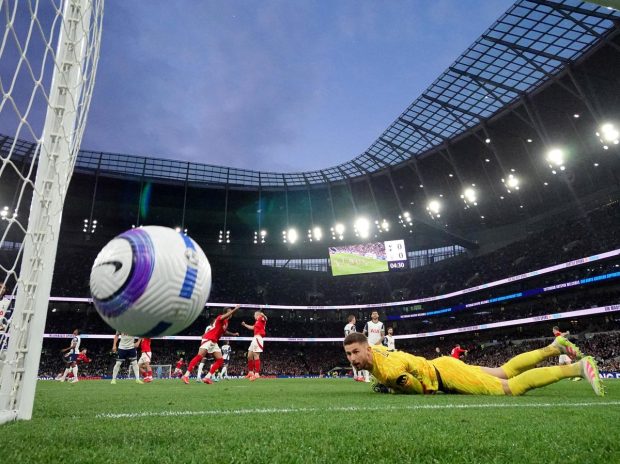In what is unquestionably one of the most ambitious endeavors in league history, the NBA is officially exploring the start of a new league in Europe.
And why not? The NBA has started leagues before. The WNBA, the G League, and the Basketball Africa League are direct products of the NBA. And that’s before mentioning numerous NBA academy projects around the world and the annual global games.
Advertisement
It makes sense for it to explore dipping its toes into Europe as well, especially due to the level of interest in basketball in that region.
The question is: Does it make sense for Europe?
The European culture and the appeal of the NBA
As a European myself, I’m personally excited about the prospect of an NBA league closer to home. However, it’d be foolish to believe everyone agrees with my point of view.
While there undoubtedly will be a segment of fans who will fully engage with the NBA brand on European soil, the league has to go into this exploration with several things in mind.
Firstly, the emotional attachment Europeans have to their sport teams is unlike how the NBA operates. Big business is often viewed as less desirable to fans over here.
Advertisement
While Americans are used to getting bombarded with ads for billion-dollar companies, and large commercial brands play a consistent role in both their media consumption and everyday lives, Europeans are more inclined to reject major companies to support local businesses.
This isn’t to say big American brands don’t exist in Europe, as they obviously do, but the feelings toward them are often divided, and their presence is not always wanted.
The same principle goes for sports.
FIBA secretary general Andreas Zagklis (L) and NBA commissioner Adam Silver speak during a news conference in New York to announce the NBA’s ongoing quest to further align with FIBA and expand its role in European basketball on March 27, 2025. (Photo by TIMOTHY A. CLARY/AFP via Getty Images)
(TIMOTHY A. CLARY via Getty Images)
If the NBA were to come in and absorb historic teams into its large branding, there will unequivocally be push-back from major segments of those fan bases.
Advertisement
Push-back doesn’t mean just skepticism. It means people with signs, protesting and walking the streets, demonstrably calling for boycotts.
It’ll work too. As any French national can attest, protests are frequent and aren’t largely ignored by governments.
Therefore, if the NBA wishes to land over here on sturdy ground, the league must arm itself with the crucial knowledge that skepticism will be the softest feeling any new league will be subjected to.
It’s a bizarre contrast, as the NBA does have millions of fans in Europe. But much of the attraction is the league is so far removed, geographically speaking, to the point where it feels as though it exists in its own bubble.
Advertisement
For European NBA fans, it’s almost a badge of honor to alter sleep schedules a few times per season to show how invested one can be in the product and to support their team away from home.
As someone who has covered the league for over 17 years from Denmark, I have lost count of how many people find some level of excitement in setting the clock to unreasonable hours just to watch a game. They actively wish to share that they got up at 4 a.m. as to showcase their dedication to the game.
A local NBA European league, playing games at proper hours, would be exciting only up to a point. Because the biggest appeal will be lacking: global superstars.
Will NBA Europe have enough star quality?
The entire point of waking up in the middle of the night is to watch the very best the game has to offer. Turning on an NBA Europe game in European prime time might be more appealing from a scheduling perspective, but if the best player such a league has to offer is in the same talent group as, say, Jordan Clarkson, would that be particularly appealing to Europeans?
Advertisement
Essentially, Europeans aren’t going to buy the NBA brand just for the sake of the NBA brand.
The NBA represents utter excellence, and unless said excellence is included in the package the league will offer, there’s really no reason for Europeans to buy in.
The NBA Paris Games in January between the San Antonio Spurs and Indiana Pacers were a major success. The league offered European sensation Victor Wembanyama and All-Stars Tyrese Haliburton and Pascal Siakam in local prime time. It offered some of the best players in the world, and that was the primary selling point.
Mind you, I’m not making the argument that we don’t have local players to support. Europe is positively loaded with talent, as evident by the rosters in the Euroleague, which are overflowing with quality players.
Advertisement
But the top-tier players, compared to the top-tier players in the NBA, are not household names on a global scale, nor are they even as well-known in Europe as the NBA’s top-rated stars, meaning the NBA could face an enormous challenge in selling the players to European audiences.
So what could NBA Europe lead with, when it can’t offer fans Nikola Jokić, Luka Dončić or Wembanyama?
There isn’t a straightforward answer.
As it stands, the NBA is stuck in a perpetual evil circle, created by its own success.
For decades, the league has hoarded talent from all around the world, making it the de facto league for anyone with genuine star upside.
Advertisement
That’s obviously hugely impressive, but it does mean that ideas like NBA Europe could be dead on arrival, unless the wealth of star players is shared.
A political divide
Furthermore, the timing of the NBA’s initiative could not be worse, as the political relationship between the United States and the European Union is worsening by the day.
Europeans are widely ignoring American goods and products, even going as far as to implement signage in grocery stores to signal which products are local and which are not.
This further underlines how quickly Europeans are to adapt to changing political landscapes, and it should leave the NBA thinking long and hard about its potential audience. Given the already volatile political climate, and how Europeans wasted no time cutting many American goods out of their shopping habits, who’s to say that won’t spill into canceling League Pass or boycotting games, for example?
Advertisement
I would heavily suspect that an element such as merchandising — viewed often as an effective way to market sports teams by having people wear clothing with team branding — would quickly be viewed as being a negative over here, to the point where wearing NBA Europe apparel, amid rising political tensions, could lead to criticism.
While the NBA is hoping fans will set aside politics and focus on the game of basketball, that’s generally not how Europeans think, and it would certainly behoove NBA commissioner Adam Silver to be very aware of how Europeans engage politically.
Should the NBA roll the dice regardless?
With all that said, there remains a “screw it, let’s try it” element to all of this.
Advertisement
The NFL actually tried this, installing an NFL Europe, which ran on and off from 1991-2007, with varying degrees of success.
It did this despite the fact that most Europeans do not play American football, making it primarily an observer sport. The NFL does have fans over here, and a significant amount, but the league never made a huge dent in installing American football as a participation sport the way the Dream Team did for basketball during the 1992 Olympics in Barcelona.
As such, if you squint, you can see how the NBA stands a greater chance at establishing a stronger foothold, given that basketball is broadly played across the continent and isn’t just for observation.
For decades, the league has discussed expanding into Europe in some capacity.
Advertisement
A powerhouse like Real Madrid has made no secret of its desire to become an NBA team, even pitching itself as an Eastern Conference candidate at one point.
Barcelona, Fenerbahçe and ASVEL also seem ready to absorb themselves into a new NBA endeavor.
That means major teams could be lining up to get involved, which should be good news for the NBA, as long as the attached fan bases also dedicate themselves to the process.
And therein lies the tough sell. How can the NBA include the fan base and make a product that’s attractive?
How should NBA Europe work?
It might come down to the rules and making the right blend between European and American play, a former NBA player, who’s currently playing in the Euroleague, told Yahoo Sports under the condition of anonymity.
Advertisement
“I think it could be interesting to see how a potential NBA Europe League would look like,” the player said. “For the brand of basketball, it’s a good idea, and ideally you’d get the best of both worlds. It would depend on how it’s structured, being that it’s two completely different types of games. I certainly think that the success of a new league would depend on the set of rules that would be applied. Is it going to be with FIBA rules or NBA rules in this new league?
“Factors such as the defensive three-second rule, not being able to knock the ball off the rim, being able to pass the ball back across the backcourt in the final minutes, and rules of physicality that they have in the NBA could potentially make or break how the new league would be viewed as a whole.
“NBA ratings and viewership has gone down over the years, and some of those factors could be a reason for that,” the player concluded.
That last part, in particular, is an interesting point. The 2024 Olympics were broadly celebrated, and those were executed by FIBA rules, not NBA rules.
Advertisement
Multiple European players have stated over time that scoring at the NBA level is easier due to a bigger sense of spacing, so perhaps a middle ground could be FIBA rules but played on an NBA court.
FIBA courts are smaller, albeit slightly, measuring 91.9 feet in length and 49.2 feet in width. In the NBA, courts are 94 feet in length and 50 feet wide.
Plenty of challenges ahead
As you can see, this won’t be an easy implementation. The NBA will have to look at this through numerous perspectives and consider all angles, especially because this will be a costly project, requiring immense work hours to launch and establish a working final product.
Advertisement
If I were to give the NBA advice, it would be this: Regardless of how many studies you go through, the amount of partners you lock in and which caliber of teams and markets you establish, you have to constantly take the emotional pulse of European fans.
The cultural difference between Europeans and Americans is stark, and if this project is in any way approached through any lens of “well, this is how we do it in America,” then NBA Europe will face extreme hardships in just getting off the ground.
Remember, Europe has basketball. Plenty of it. There are established teams with rich histories. Most of the NBA’s MVPs in recent years are from over here (granted it’s just two players, with Jokić and Giannis Antetokounmpo combining for five). We are not lacking in skills, nor are we lacking in interest.
For the NBA to enter this market, the intention has to be nailed perfectly. That means pumping money into the further advancement of the European basketball infrastructure, nurturing small clubs instead of running them over and, of course, finding a way to entice fans to engage with the actual on-court product instead of using them solely as another marketing platform.
Advertisement
And finally, don’t go overboard with games. Take a page out of the NFL’s book. Less is more. If you establish a 16-team league, start your inaugural season with perhaps a 15-game slate per team for the regular season. Build up anticipation week-by-week, instead of running teams and players into the ground, as they still have to maintain their responsibility to their national leagues.
Do that, and perhaps the NBA can actually stick and become an integral part of basketball in Europe.
This news was originally published on this post .







Be the first to leave a comment